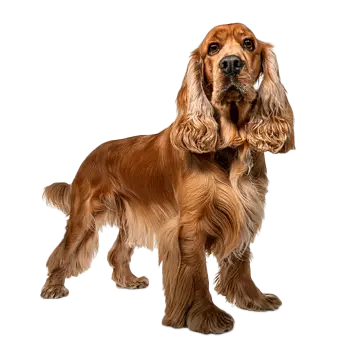The Cocker Spaniel presents a picture of balanced beauty that combines sturdy sporting capability with elegant refinement, creating the smallest yet perhaps most beautiful member of the Sporting Group. Every aspect of proper Cocker Spaniel structure contributes to both functional ability and aesthetic appeal, producing a dog that moves with grace and style while maintaining the substance required for sporting work. The breed's distinctive appearance has made it a perennial favorite in show rings and family homes alike.
Size standards establish the Cocker Spaniel as a compact dog with precise height requirements that maintain breed type. Ideal males measure fifteen inches at the withers, with females measuring fourteen inches. Dogs exceeding these heights by more than one-half inch are disqualified from conformation competition, reflecting the importance of proper size to breed identity. Weight should be proportionate to height, typically ranging from twenty to thirty pounds, with overall balance and substance taking precedence over specific numbers.
The head represents the Cocker Spaniel's most distinctive feature, refined and chiseled with smooth, clean lines that distinguish the breed from all other spaniel varieties. The skull is rounded but not exaggerated, with a pronounced stop creating the characteristic facial structure. The muzzle is broad and deep, approximately half the length of the skull, with square jaws accommodating strong teeth meeting in a scissors bite. This distinctive head type immediately identifies the Cocker Spaniel.
The eyes contribute enormously to the Cocker Spaniel's appealing expression, often described as soulful, dreamy, or pleading. Set to look directly forward, the eyes are round, full, and dark brown in color with tight-fitting lids. The expression conveys intelligence, gentleness, and appeal, ranking among the breed's most captivating features. Light-colored or protruding eyes detract from proper type and expression.
The ears represent perhaps the most recognizable Cocker Spaniel feature, long and lobular, set no higher than the lower part of the eye. Covered with long, silky hair, they frame the face beautifully and create the flowing silhouette characteristic of the breed. The ear leather is fine and extends at least to the nose when drawn forward. Proper ear set and abundant furnishing are essential to correct breed type.
The magnificent coat distinguishes the Cocker Spaniel from other sporting breeds, flowing and silky with abundant feathering that creates spectacular visual effect when properly maintained. The texture is silky, flat or slightly wavy, permitting relatively easy care despite impressive length. Excessive coat that obscures the dog's true lines or requires extensive trimming to maintain is penalized. Proper coat develops with maturity but should never interfere with function.
Color varieties in the Cocker Spaniel offer tremendous diversity within breed parameters. Black variety includes jet black and black with tan points in specified locations. ASCOB encompasses any solid color other than black, from lightest cream through deep chocolate and red shades. Parti-color includes two or more distinct colors with white predominating, creating striking patterns. Each variety competes separately in conformation, honoring the breed's color heritage.
Body structure combines compact strength with flowing elegance. The topline slopes gently from withers to tail set, with deep chest providing heart and lung room. Strong, well-muscled hindquarters drive efficient movement that covers ground with apparent ease. The tail, customarily docked in countries where permitted, is set on and carried in line with the topline, expressing the merry temperament through constant wagging.
Affectionate With Family
★★★★★
The Cocker Spaniel forms extraordinarily devoted bonds with family members, thriving on close companionship and physical affection. These dogs express their love through constant tail wagging, snuggling, and their signature soulful gazes that melt hearts.
Good With Young Children
★★★★★
The Cocker Spaniel demonstrates remarkable patience and gentleness with children, making them ideal family dogs. Their tolerant nature and playful disposition create natural partnerships with youngsters when both receive appropriate guidance and supervision.
Good With Other Dogs
★★★★☆
The Cocker Spaniel typically displays friendly, sociable behavior toward other dogs when properly socialized from puppyhood. Their merry, non-confrontational nature makes them excellent candidates for multi-dog households and enjoyable participants at dog parks.
Shedding Level
★★★☆☆
The Cocker Spaniel sheds moderately throughout the year with some seasonal variation. Regular brushing manages loose hair effectively while maintaining the beautiful silky coat that defines the breed's elegant appearance.
Coat Grooming Frequency
★★★★★
The Cocker Spaniel requires substantial grooming commitment to maintain their magnificent coat. Daily brushing prevents matting, while professional grooming every four to six weeks ensures proper coat management and keeps these beautiful dogs looking their best.
Drooling Level
★☆☆☆☆
The Cocker Spaniel is not prone to drooling under normal circumstances. Their refined facial structure prevents excessive salivation, making them clean, presentable companions who won't leave moisture marks on furniture or clothing.
Openness To Strangers
★★★★☆
The Cocker Spaniel typically greets strangers with enthusiastic friendliness and their trademark wagging tail. While they may bark to announce visitors, they generally warm quickly to new people, reflecting their merry, trusting temperament.
Playfulness Level
★★★★☆
The Cocker Spaniel maintains joyful playfulness throughout life, approaching games and activities with genuine enthusiasm. Whether fetching, exploring, or simply romping with family, they participate wholeheartedly in play that strengthens bonds.
Watchdog/Protective Nature
★★★☆☆
The Cocker Spaniel provides reliable alert barking when visitors approach but lacks strong protective instincts. They announce arrivals adequately but typically greet everyone, including strangers, with wagging tails rather than defensive posturing.
Adaptability Level
★★★★☆
The Cocker Spaniel adapts well to various living situations from apartments to houses with yards. Their moderate size and agreeable temperament suit diverse environments, though they always require adequate exercise and, most importantly, human companionship.
Trainability Level
★★★★☆
The Cocker Spaniel demonstrates excellent trainability, responding enthusiastically to positive reinforcement methods. Their eager-to-please nature and food motivation make training productive and enjoyable, though their sensitivity requires patient, gentle handling.
Energy Level
★★★☆☆
The Cocker Spaniel possesses moderate energy requiring regular daily exercise without extreme athletic demands. After appropriate activity, they settle contentedly for companionship time, balancing playful enthusiasm with relaxed household presence.

